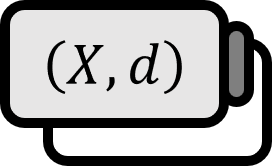Diameter of a Set in a Metric Space
Definition1
Let $E$ be a subset of the metric space $(X,d)$. And suppose $S$ is as follows.
$$ S=\left\{ d(p, q) : \forall p, q \in E\right\} $$
Then, the least upper bound $\sup S$ of $S$ is called the diameter of $E$ and is denoted by $\operatorname{diam} E$.
Explanation
Let $\left\{ p_{n} \right\}$ be a sequence in the metric space $X$, called $E_{N}=\left\{ p_{N},p_{N+1},p_{N+2},\cdots \right\}$. Then, by the definition of a Cauchy sequence and the diameter, $\left\{ p_{n} \right\}$ being a Cauchy sequence is equivalent to $$ \lim \limits_{N\to\infty} \operatorname{diam} E_{N}=0 $$.
Theorem
(a) Let $E$ be a subset of the metric space $X$. Then, the following holds.
$$ \operatorname{diam} \overline{E} = \operatorname{diam} E $$
Here, $\overline{E}$ is the closure of $E$.
(b) Let $\left\{ K_{n} \right\}$ be a sequence of compact sets in a metric space. If $K_{n}\supset K_{n+1}$ and
$$ \begin{equation} \lim \limits_{n\to\infty} \operatorname{diam}K_{n}=0 \end{equation} $$
then, $\bigcap _{n=1}^{\infty}K_{n}$ consists of exactly one point.
Proof
(a)
Since $E \subset \overline{E}$, the following is evident.
$$ \operatorname{diam} E \le \operatorname{diam} \overline{E} $$
Let any positive number $\varepsilon >0$ be given. And choose two points $p, q\in \overline{E}$. By the definition of closure and limit points,
$$ d(p,p^{\prime}) \lt \varepsilon \quad \text{and} \quad d(q, q^{\prime}) \lt \varepsilon $$
there exists $p^{\prime}, q^{\prime} \in E$ satisfying. Thus, the following holds.
$$ \begin{align*} d(p, q) &\le d(p,p^{\prime}) +d(p^{\prime}, q^{\prime})+d(q^{\prime}, q) \\ &\le 2\varepsilon + d(p^{\prime}, q^{\prime}) \\ &\le 2\varepsilon + \operatorname{diam} E \end{align*} $$
Since this is true for any $p, q \in \overline{E}$, the following holds.
$$ \operatorname{diam} \overline{E} \le 2\varepsilon + \operatorname{diam} E $$
Since $\varepsilon$ is any positive number, the equation below holds.
$$ \operatorname{diam} \overline{E} \le \operatorname{diam} E $$
Therefore, $\operatorname{diam} \overline{E}=\operatorname{diam} E$ is true.
■
(b)
Let $K=\bigcap _{n=1}^{\infty}K_{n}$. Then, $K$ is not empty. If $K$ contains more than two points, then $\operatorname{diam} K >0$. However, since $n$ for each $K_{n} \supset K$, the following holds.
$$ \operatorname{diam} K_{n} \ge \operatorname{diam} K $$
This is a contradiction for $(1)$, so it is wrong that $K$ contains more than two points. Therefore, since $K$ is not empty and does not contain more than two points, it consists exactly of one point.
■
Walter Rudin, Principles of Mathmatical Analysis (3rd Edition, 1976), p52-53 ↩︎
